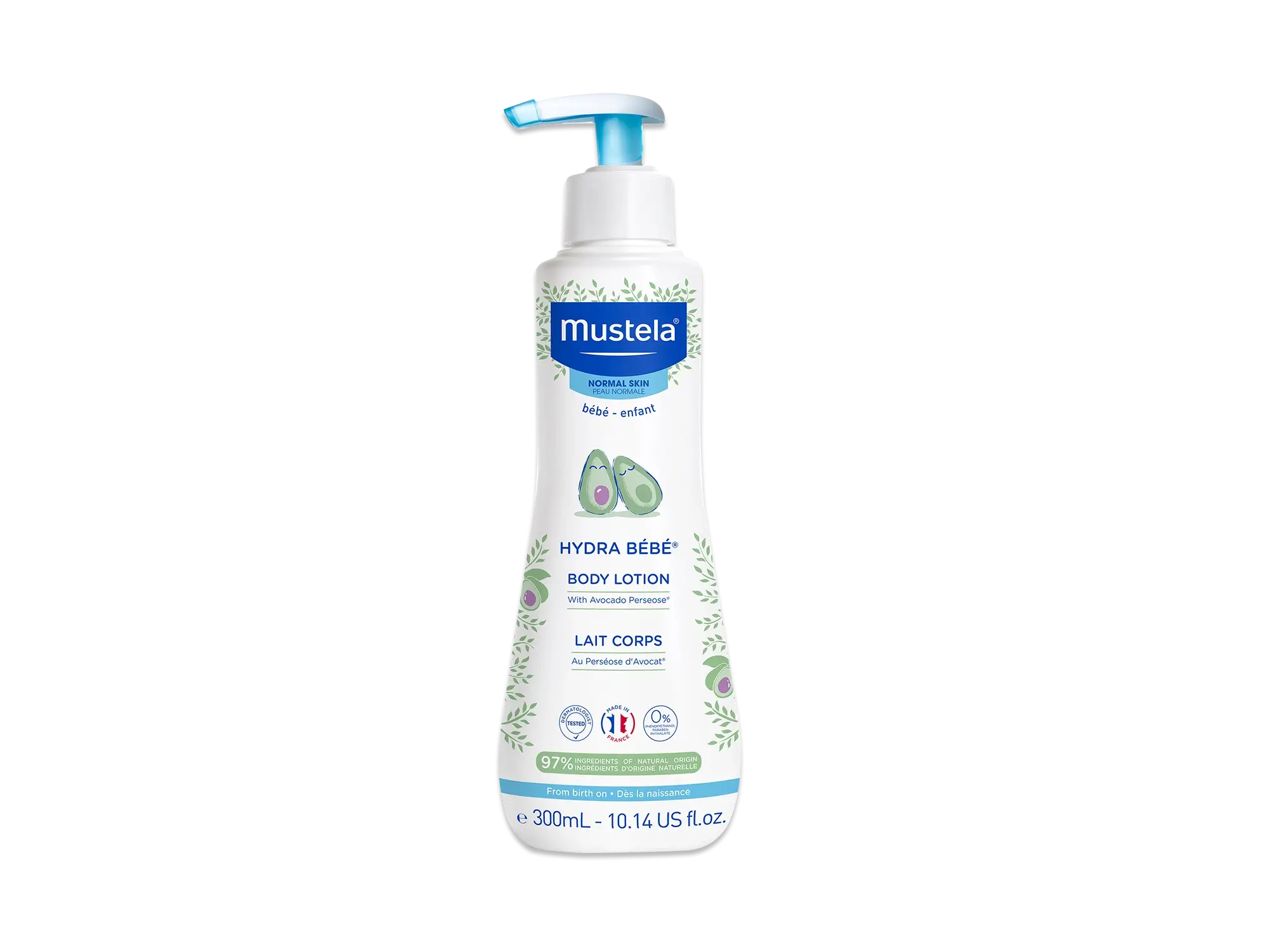Your little one is constantly changing. Just when you think you’ve found a consistent sleep schedule for your new baby, they suddenly begin having difficulty falling asleep and staying asleep. If this sounds familiar, the next parenting hurdle has appeared: sleep regression.
Dealing with sleep difficulties that seem to come from nowhere can be frustrating and tiring for you as well as your baby.
If you’re in the throes of sleepless nights (or sleepless naps!), the experts at Mustela are here to help. We’ll explain what sleep regression is, why it happens, and what you can do to work through it.
Table Of Contents
- What Is Sleep Regression?
- Developmental Milestones And Sleep Regression
- Major Signs Of Sleep Regression
- Tips For Surviving Sleep Regression
- When To Consult A Doctor About Sleep Regression
What Is Sleep Regression?
Sleep regression is more than just one night of bad sleep. Simply put, it’s when your baby or toddler was in a pattern of sleeping well and then suddenly has trouble falling asleep or staying asleep (naps or nighttime).
If your child has only had a night or two of poor sleep, it could just be that they are sick, stimulated by changes in the environment, or discombobulated from travel.
But if your baby has trouble sleeping for more than a couple of consecutive days, you are probably dealing with sleep regression. Depending on the baby, sleep regression can last anywhere from two to six weeks.
This change in sleeping habits usually occurs around developmental milestones when your baby’s body and mind are undergoing significant changes. You might even notice that your child is extra hungry and clingy.
To help you tackle the sleeping woes, let’s talk about various sleep regressions and the developmental milestones around them.
Developmental Milestones And Sleep Regression

You’ll clap and cheer when your little one learns to roll over by themselves or takes their first steps. But their new achievement might go hand-in-hand with a few weeks of sleep regression.
Let’s take a look at what’s happening to your little one during these times.
The Four-Month Sleep Regression
Around four months old, your baby’s sleep cycle is undergoing significant change, which may mean trouble sleeping. Plus, they are reaching some pretty big developmental milestones, like rolling over.
Your infant might start rolling over at night, which could wake them up or make them feel stuck if they don’t want to be on their tummy.
The Six-Month Sleep Regression
Around six months, your baby may begin sitting up by themselves, crawling, or cutting teeth. Some little ones even start trying to pull up to stand.
All of this exciting new movement and development can be the cause of sleep regression around six or seven months of age.
The Eight-To-Ten-Month Sleep Regression
If your baby hasn’t yet, they will begin to experiment with crawling and standing around eight to ten months. This might also be when your little one starts missing you when you’re not around.
That’s right — separation anxiety. It can make bedtime a nightmare.
The Twelve-Month Sleep Regression
If your little one isn’t already walking, get ready for those first steps soon! Additionally, this is the time when your baby’s brain is busy as they’re learning to communicate and use words.
Around one year of age, your baby might also start to transition from two naps a day to just one, which means they may fight that second nap.
The Eighteen-Month Sleep Regression
This sleep regression is largely related to behavior. Your little one is learning how to express their opinions and push boundaries. They may not want to go to bed at all, or they may want you to stay with them.
Plus, since they are learning to communicate more and more, they might have trouble turning their brain off to fall asleep.
The Two-Year-Old Sleep Regression

Sleep regressions aren’t just for babies! Two year olds are sometimes beginning to move out of taking a nap during the day, which means they might resist nap time. And when that happens, your little one may have trouble falling asleep at night because they’re overtired.
Similar to the eighteen-month regression, it might also be that your child doesn’t want you to leave the room or that they’re now capable of expressing their desire not to go to bed.
Your toddler’s imagination is also active at this age and might keep them from falling asleep easily (monsters, anyone?).
Major Signs Of Sleep Regression

1) Waking Up More During The Night
This may seem like a no-brainer, but when you’re in the midst of a full-on sleep regression — and going without sleep yourself — you may not take into account the most obvious signs.
If you notice that your baby is waking up two, three, four, or more times during the night or that their sleep schedule has changed dramatically in a short period of time, it could be a signal that your little one is regressing.
First and foremost, be patient with your little one. They’re not doing it on purpose.
Try some of the tips in this article to help calm your baby and, hopefully, get them back on a regular sleep schedule as soon as possible.
2) Trouble Falling Asleep
Does your little one have trouble falling asleep at night even though they exhibit the classic traits of being tired? They could be suffering from sleep regression.
One of the best things you can do to help you recognize the changes in their sleep behavior is to get to know their regular habits.
For example, your little one may go down for the night around 8 p.m., wake up at 11 p.m., and then sleep for the rest of the night. Then, suddenly, they’re awake and alert (and cranky) well past 9 p.m. with no signs that they’re going to fall asleep.
That’s a major change in sleep behavior and could indicate a regression.
You might not see it and know when to try the tips in this article if you don’t know your baby’s regular habits and behaviors.
3) Resisting Nap Time

Similarly, some babies will resist going down for a nap when they’re going through a sleep regression.
Of course, children need fewer naps as they grow, but if one week they’re taking two uninterrupted naps during the day and the next week they don’t want to take any, that could be a sign that something is amiss.
Again, it helps to know your baby’s regular habits so that if something does change, you have a benchmark for comparison.
4) Seeming Crankier Than Usual
When your baby isn’t getting the sleep they need, they’re going to be crankier than usual. They’re dealing with the feelings and emotions of their growing body and don’t have any way to express things other than to cry and fuss.
In the middle of a sleep regression, you’ll probably be crankier than usual, too. As we mentioned earlier, be patient with your little one (and yourself).
Get started on the tips in the next section as soon as you can to help your baby get back to normal. And, don’t be afraid to talk to a doctor or other medical professional for advice on how to end the sleep regression sooner rather than later.
5) Wanting To Eat More Often
One of the most common causes of sleep regression is a growth spurt and the hunger that comes with it.
During these growth spurts, your baby is going through some major physical, mental, and emotional changes. As a result, they need more nutrition to keep up with their body’s demands.
If your little one can communicate their need for food with words, be prepared for them to ask for more snacks and more food at meals. If they haven’t reached that milestone yet, be prepared for a bit more tears.
Tips For Surviving Sleep Regression
The important thing to remember when you’re in the middle of any sleep regression is that it won’t last forever. But in the meantime, you’ll need some tips and tricks to survive.
1) Practice Good Sleep Habits
For the best chance for your baby to snooze soundly, create an atmosphere that promotes sleep.
- Dim the lights and keep all screens out of their nursery.
- Keep their room cool.
- Dress them in pajamas that are appropriate for the temperature. If your little one deals with itchy eczema, help them rest easy with Stelatopia Skin Soothing Pajamas, designed especially for eczema-prone skin.
- Keep the house as quiet as possible and use a noisemaker to drown out street noise if necessary.
- Put them to bed with a pacifier. This is considered safe sleep and might help your little one soothe themselves back to sleep.
- Figure out your child’s sleeping schedule, which is usually not a fixed time but, rather, a certain number of hours since they last woke up.
2) Maintain A Routine For Naptime And Bedtime
Having a pre-sleep routine will help your little one (baby or toddler!) clue into the fact that it’s time for bed. Your bedtime routine could include a bath, pajamas, and a couple of songs or books.
Especially when you’re dealing with the eighteen-month or two-year sleep regression, make sure you stick to your routine and boundaries! If you read one story before bed or sing one song, don’t always let them talk you into “just one more.”
Also, consider keeping your toddler in a crib (rather than moving into a toddler bed) so they can’t get out of bed during a sleep regression period.
If a bath is part of your wind-down routine, use products that are gentle and won’t irritate your baby’s delicate skin. Between Mustela Foam Shampoo for Newborns, Stelatopia Cleansing Oil, and other essentials, we have something to make bath time special and soothing for every age.
Giving your baby a massage before bed can also be a great addition to your routine to help them calm down. A massage with our Baby Oil can moisturize your little one’s skin and help them relax at the same time!
3) Put Your Baby To Bed Drowsy
While it’s tempting to enjoy all the baby snuggles you can, avoid putting your baby in bed completely asleep. Instead, rock and snuggle until they’re sleepy, then place them in their crib to fall asleep on their own.
During a sleep regression, you might find yourself doing whatever it takes just to get your little one to fall asleep. However, you do want your baby to learn how to fall asleep (and put themselves back to sleep) alone.
Comfort your little one during the hard moments, but avoid using a technique that they’ll later come to rely on to fall asleep.
Similarly, give your baby plenty to eat during the day to accommodate their growth spurts and all the changes in their body, but don’t rely on a bottle to get them to fall asleep.
4) Don’t Let Your Baby Become Overtired
If your baby is moving from two naps to one nap or one to none, you probably have an overtired little one on your hands. If your baby is too tired at the end of the day, it will be even more difficult for them to fall asleep.
Instead of getting rid of a nap entirely (or going immediately from two naps to one), insist on rest time even if you know your child won’t fall asleep. Also, consider making bedtime earlier when naps become shorter or disappear altogether.
5) Consider Sleep Training
Sleep training is not for everyone, but it can help your child figure out how to go to sleep, soothe themselves, and fall back asleep without any help. Experts recommend beginning around four to six months old.
6) Practice Safe Sleep

When a sleep regression occurs, you may feel the need to do whatever it takes to help your little one catch some ZZZZs, including adding toys, pillows, blankets, and bumpers to their crib.
Resist this urge and practice safe sleep at all times.
Here are some tips to help you do that:
- Keep the sleeping area free of loose items
- Choose a tight-fitting bottom sheet
- Avoid the top sheet until your baby is older
- Always put your baby to sleep on their back
- Try a swaddle or sleep sack to keep your baby warm at night
Putting your little one down in an uncluttered crib and practicing safe sleep habits can help them experience pleasant nights and restful naps whether they’re going through a sleep regression or not.
7) Evaluate Your Baby’s Bedding
Evaluating your baby’s bedding is always a good idea. Choose a firm mattress that’s comfortable and supportive without being too soft or fluffy.
Check the fit of the mattress so there are no big gaps (two fingers or more) between the edge of the sleep surface and the inside of the crib.
You may also consider purchasing a breathable mattress that allows air to flow through the mattress itself. Just make sure that it fits the crib according to the suggestions above.
8) Remove Distractions
We’ve touched on this several times, but it’s worth repeating because it can have a huge impact on your little one’s sleep habits.
Excess noise, light, and other visual stimulation can make it hard for a baby of any age to fall asleep, stay asleep, and self-soothe at night.
Remove as many distractions from the space immediately around their sleep area as possible. This includes mobiles, wall hangings, stuffed animals, toys, pillows, and anything else that might catch their attention and pique their curiosity.
Keep the living space quiet, and consider hanging blackout curtains to minimize light from the outside.
With the right sleeping environment, you’ll be better able to help your little one fall asleep faster — and stay asleep longer — whether they’re in a sleep regression or resting normally.
9) Keep Them Active When They’re Awake
Keeping your little one active while they’re awake is a great way to help reduce the effects of sleepless nights and skipped naps.
Just like you, physical and mental “exertion” can tire out your baby so they’re ready to go to sleep when naptime or bedtime rolls around.
Play with them. Give them toys to play with on their own. Go for a walk. Take them to visit their grandparents. Arrange for play dates.
This level of stimulation can have a tiring effect on your little one and prepare them to fall asleep faster when it’s time. Just make sure they don’t become overtired, which, as we mentioned, can actually have the opposite effect.
It can also be helpful to expose them to natural light while they’re awake. Doing so builds a healthy circadian rhythm that reinforces longer and deeper sleep during the night.
That said, be sure that your baby isn’t exposed to too much direct sunlight. Cover their skin with long sleeves, pants/dresses, and hats, always apply sun protection — like Mustela mineral sunscreen — and keep them in the shade as much as possible.
Indirect sunlight is just as effective at building a healthy circadian rhythm as direct sunlight and is much safer for newborns, babies, and small children.
10) Let Your Little One Fuss For A Bit
Giving your little one time to self-soothe and go back to sleep on their own is a great way to reinforce healthy sleeping habits at any age.
If your baby wakes up in the middle of the night and starts crying, let them fuss for a bit to see if they go back to sleep. If they continue to fuss, consider checking on them to see if anything is wrong.
If you know for sure that they’re in the midst of a sleep regression, you may need to feed them when they do wake up to keep them happy, healthy, and full so they can deal with the growth spurt they’re going through.
That said, try to avoid picking up your baby or interacting with them at the first signs that they’re awake. Doing so may give them just enough stimulation to wake up completely.
When To Consult A Doctor About Sleep Regression

As we’ve mentioned, sleep regression is completely normal and is nothing to be worried about. After a while, your baby’s sleep habits will even out again.
If, however, you notice your little one exhibiting other signs that interfere with their sleep — persistent nightmares, high fever, blood in their nose, swollen glands, an earache — consult a doctor or pediatrician as soon as possible.
Sleep Regression Will Pass
In the end, sleep regression, like all phases of raising a baby, will pass. Until it does, stick to your routine to help your baby get the sleep they need now and create good habits for the future.
Set your little one's nursery up for good sleep, keep them cozy in their pajamas, try a calming massage with Baby Oil, and help them learn to fall asleep on their own.
Soon, your baby’s sleep regression will be a thing of the past, and you — and your little one — will be sleeping soundly again!























